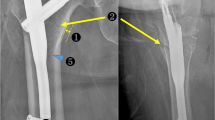Summary
The progress of 182 patients who presented with intertrochanteric fractures was followed over a six month period. Eighty-seven patients were treated using Thornton/McLaughlin nail plates and 95 were treated using Ender's intramedullary nails. Each fracture was classified according to radiological position and mechanical stability.
The results show that the more unstable fractures are more likely to develop unsatisfactory results. Post operatively, the different mechanical complications have been recorded at various stages. Those fractures fixed with a nail plate tended to develop varus deformity resulting from either bony collapse around the implant or implant failure, whereas those fixed with Ender's nails did not develop deformity at the fracture site but encountered distal migration of the nails at the knee.
The use of a classification system in predicting post operative mechanical complications is considered, and the comparative merits and disadvantages of the two fixation systems is discussed, with suggestions for improvement in operative technique.
Résumé
L'évolution post-opératoire de 182 sujets atteints de fracture per-trochantérienne du fèmur a été suivie sur une période de six mois. 87 malades ont été ostéosynthésès par clou-plaque de Thornton-McLaughlin et 95 par enclouage centro-médullaire selon la technique d'Ender. Toutes les fractures ont été classées d'après leur aspect radiologique et leur stabilité mécanique.
L'étude des résultats montre que ce sont les fractures le plus instables qui donnent le plus souvent de mauvais résultats. Dans les suites opératoires, les différentes complications mécaniques ont été observées dans des délais variables. Les fractures fixées par clou-plaque tendent à se déplacer en varus, soit en raison du tassement de l'os autour du matériel, soit en raison d'une défaillance du matériel lui-même. Par contre les fractures ostéosynthésées par clous d'Ender, ne se déplacent pas au niveau du foyer de fracture mais présentent une migration distale des clous au niveau du genou.
Les auteurs proposent une classification permettant de prévoir les complications mécaniques post-opératoires. Ils discutente les avantages et les inconvénients respectifs des deux systèmes de fixation et suggèrent un certain nombre d'améliorations techniques.
Similar content being viewed by others
References
Ender JE, Simon-Weidner R (1970) Die Fixierung der trochanteren Brücke mit runden elastischen Condylennägeln. Acta Chir Austr 1:40–41
Kuntscher G (1966) Zur operativen Behandlung der pertrochanteren Frakturen. Zentralbl Chir 91:281–285
Hall G, Ainscow DAP (1981) Comparison of Nail Plate Fixation and Ender's Nailing for Intertrochateric Fractures. J Bone Joint Surg 63 B: 24–28
Author information
Authors and Affiliations
Additional information
Formerly Orthopaedic Senior House Officer, Currently Registrar in Orthopaedic Surgery, Wexham Park Hospital
Lately Orthopaedic Consultant (Mr. Lowe died on 6th May, 1982)
Formerly Orthopaedic Registrar
Rights and permissions
About this article
Cite this article
Hayward, S.J., Lowe, L.W. & Tzevelekos, S. Intertrochanteric fractures: A comparison between fixation with a two-piece nail plate and ender's nails. International Orthopaedics 7, 153–158 (1983). https://doi.org/10.1007/BF00269499
Issue Date:
DOI: https://doi.org/10.1007/BF00269499




